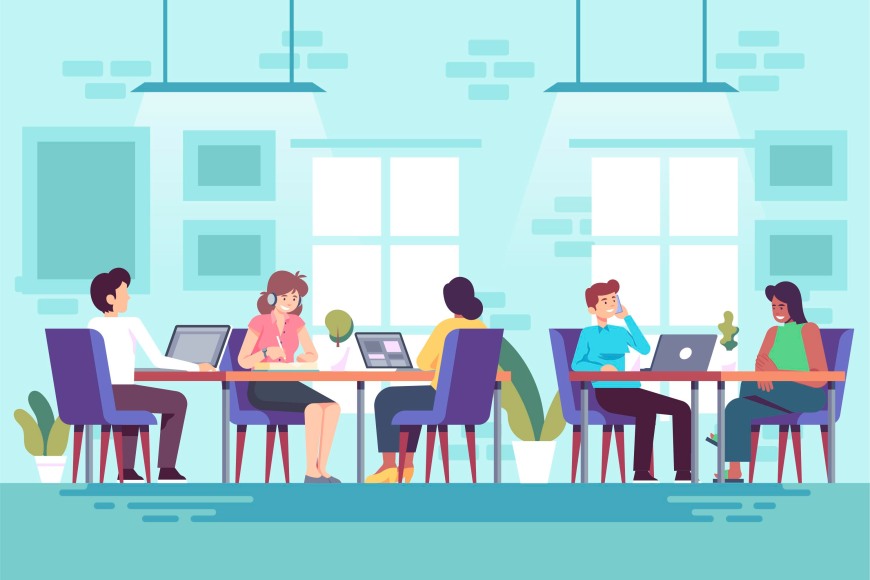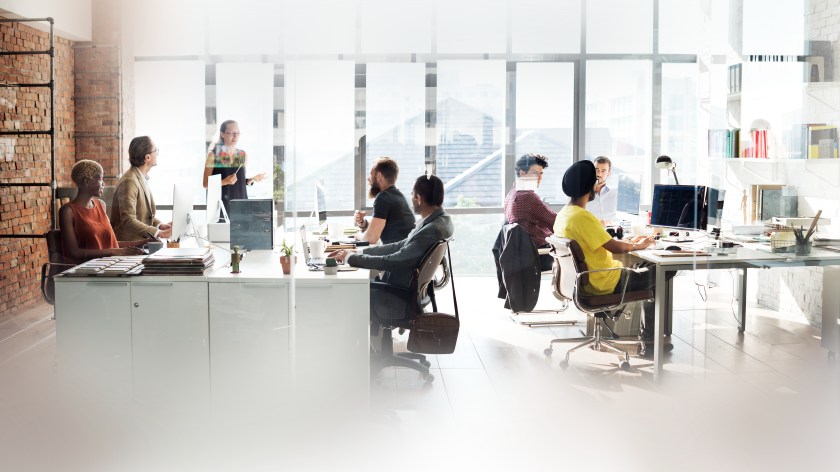Coworking spaces are a creative and productive hub for freelancers, entrepreneurs, and remote employees. Still, there is a certain level of dressiness expected in these spaces that is similar to that in a traditional workplace, i.e., you have to wear something appropriate for the workplace environment, therefore keeping it professional at all times.
Dress code or no dress code for coworking spaces is an ongoing debate that has seen its fair share of discussions. Its opponents believe that enforcing a dress code ignores personal style and changes in fashion trends, and limits creative freedom.
At the same time, those who support it argue that not following a dress code devalues the work environment, highlighting the importance of showing professionalism in coworking spaces.
Whether you support the idea or not, networking is at the heart of coworking spaces, and a dress code sets a professional tone for that environment. So, what is your best bet to achieve a professional look without overdressing or breaking the bank if you are a freelancer operating out of a coworking space?
This article will introduce simple and easy steps to maintaining professionalism outside a traditional corporate setting.
Try Understanding and Following General Rules
When you go to a coworking space, there are a few things you should know. You should first consider how most of your coworkers’ dress in the coworking space. If most people like to dress more casually and less formally, then it would be best for you to do the same to avoid sticking out too much and distracting people from their work. After all, it is essential to remember that good social etiquette and dress code are essential in any professional setting.
For example, in a typical coworking space, you should dress appropriately to respect the diverse cultures of others, since people in the coworking space are expected to be considerate of other coworkers. There should be no smoking, drinking, or animals in the space (unless they are service animals), as it may bother coworkers with allergies.
In addition, you should only bring food (light snacks are okay) into the coworking space if that’s permitted. Refer to your coworking space’s reception or help desk for more insight on specific rules that may be enforced in the coworking space.
Dress with Respect
Dressing with respect is a common courtesy necessary for any public setting, but it is especially important in a business environment. While there is no specific “right” way to dress for a coworking space, it is important to consider how you feel about your clothing choices and how others might perceive you as you navigate a business-centered circle.
A series of studies conducted by New York University and Princeton University revealed that most people who opted for “smarter” or “richer” looking clothing were perceived as more competent by others compared to those who wore “rugged” looking clothes.
Evidently, dressing appropriately in the workplace inspires a sense of professionalism. It gives others an idea of who you are in one glance, resulting in a positive impression on others, which is important for both networking and business.
There should always be respect for each individual’s personal preference, but be mindful of your work environment, as it is usually considered appropriate to dress close to the level of formality for your work environment. Avoid revealing clothes or overly short items such as shorts or short skirts. Wear closed shoes to limit tripping hazards, and avoid anything too loud or distracting that may disturb those around you.
For example, if the other people in your shared workspace area wear jeans and t-shirts, this clothing choice would also be fine. However, dressing up slightly may be necessary if everyone else is wearing business attire.
Are you undecided about your company’s culture and values?
Contact Growth Hackers
Look Tidy
As with any professional environment, you should keep your attire and your desk or workstation neat, tidy, and appropriate for the environment in which you are working.
We usually spot what is wrong with our outfits as soon as we leave the house. The problem is, it’s too late to do anything about it, and we have to go on living with our clothes on. So, learn to spot the flaws in your outfits at a glance and fix them before it is too late. For example:
- Check for buttons that are not buttoned up properly.
- Are there any loose threads or irregularities in the seams?
- Do you have stains on your dress or shirt?
Invest in the Basics
It means investing in dynamic business attire, pieces, and equipment. Investing in clothes made from lightweight and practical materials will help you look tidy when your clothes are not covered in sweat from a long day of working on a project. In addition, remember to keep your hair and facial hair neat and well-trimmed to maintain an intelligent look.
As for your workstation, preparing it before you start working is important, especially when you are in a public place like a coworking space. For example:
- Put things you often need on top of the desk within easy reach, such as your phone and water bottle
- Arrange items neatly at the bottom of your desk to prevent someone from tripping over or falling
- Clear out all the clutter, like lunch leftovers, by the end of your workday
- Keep any irrelevant objects you might not need off the workspace during your work time
Productivity can thrive in organized and distraction-free environments. It seems reasonable enough, as some people find it difficult to focus on certain tasks in a cluttered space, according to a study by Princeton University.
Smart Casual: Why might this be the best choice?
Many freelancers prefer to work in a casual environment, not just because they are looking for a more relaxed setting but also because they need to be able to switch gears when the demands of their work change. For example, some freelancers operate on a hybrid basis, i.e., between a shared-working space/home and an office.
They might need to be meeting-ready, jumping from casual attire to a more formal, business-casual outfit. Or, some may need to meet with potential clients face-to-face or online. Smart-casual can combine both styles as it provides a relaxed feel while maintaining a sense of professionalism.
With this attire, you can mix and match daywear pieces such as blazers and trousers, jeans and sweaters, or even khakis. It shows that you are professional but not uptight or rigid, that you take the dress code seriously, and want to be taken seriously by your peers in the coworking space. In contrast, other types of clothing for a coworking space might be too informal or formal.
With or without dress code for coworking spaces, we’ll help you become more efficient at work!
What is Smart Casual Attire?
The term “smart casual” may be a new trend in the fashion industry, but it is not new to the business world. It is a term that has been around for years and refers to the middle ground between what you would wear on a job interview and what you would wear on an everyday basis.
The best way to dress smart-casual is with business-like clothes that do not show any logos or branding but are still polished enough for the office. These clothes typically include blouses, button-down shirts, slacks, skirts, sweaters, and cardigans.
Let us explore what smart casual means for men’s and women’s fashion:
For men
- Shirts: This can be a button-up shirt or polo shirt for a more casual look
- Jackets and blazers: bomber jackets are a classic item that makes the look a little laid-back, while blazers, especially in monotone colors, can be mixed and matched with different items
- Pants: Light pants with some stretch, such as chinos or khakis, are best for comfort during the day and will not restrict movement when you need to walk up or down stairs or move around
- Jeans: Easy and simple as always for an effortless look
- Shoes: These can be leather or Oxford shoes for a slim and sleek look and sneakers or loafers for a comfortable and stylish look.
- Accessories: Leather belts, wallets, and even iPhone cases. Remember, a quality belt and watch are essential for any man’s wardrobe.
For women
- Shirts: Shirts made with lightweight fabric, such as button-up collars and sleeve-up shirts, look polished
- Pants: Such as dress slacks, chinos, denim, and cotton pants, all of which are essentials for everyone
- Blazers: This item can be considered quite formal, but it helps achieve a dressier appearance if worn with casual outfits.
- Shoes: Oxfords or loafers for a business-like flair. Unlike formal occasions, less formal footwear such as flats or ballet slippers is acceptable for smart casual rather than heels or open-toe sandals.
- Accessories: Minimalist necklaces, earrings, rings, bracelets, and watches that can work with any outfit.
Final Words on Coworking Spaces’ Dress Codes
Dressing appropriately in a coworking space is a common courtesy shared by many. It might seem like a little gesture, but wearing the wrong outfit in the wrong environment can be just as crucial as dressing appropriately in a more formal setting.
Ultimately, the dress code is not about sporting a traditional business suit but about combining comfort and efficiency to inspire a confident and competent feeling among peers in the shared work environment.
Growth Hackers is a certified online marketing agency helping businesses from all over the world grow. There is no fluff with Growth Hackers. We help entrepreneurs and business owners build long-lasting brands, start coworking space businesses, increase their productivity, generate qualified leads, optimize their conversion rate, gather and analyze data analytics, acquire and retain users and increase sales. We go further than brand awareness and exposure. We make sure that the strategies we implement move the needle so your business grow, strive and succeed. If you too want your business to reach new heights, contact Growth Hackers today so we can discuss about your brand and create a custom growth plan for you. You’re just one click away to skyrocket your business.










1 Comment
An insightful perspective on the advantages and drawbacks of having a dress code in co-working spaces, offering valuable insights for those navigating the dynamics of fostering a collaborative and comfortable work environment.